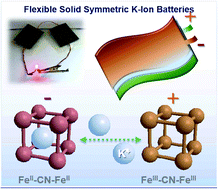High rate and stable symmetric potassium ion batteries fabricated with flexible electrodes and solid-state electrolytes†
Abstract
Aqueous batteries designed with K-ions have outstanding potential for future energy storage applications. When coupled with cathode and anode materials both operating with the intercalation mechanism, K-ion batteries could have kinetics and stability similar to Li-ion batteries in principle but with a much lower cost. However, the electrode materials developed so far still suffer from poor stability and limited activity, especially from the anode side. Herein, a new concept of symmetric K-ion batteries was developed by using potassium Prussian blue (KPB) as a bipolar material. The KPB particles were grown on flexible and strong wiper cloth substrates that were pre-coated with polypyrrole (PPy). The use of PPy as an interlayer not only boosted electrical conductivity but also ensured uniform growth of KPB particles. The synthesized KPB@PPy@wiper electrodes have superior flexibility and stability, and exhibited two redox pairs both with remarkable kinetics. When used as bipolar electrodes in combination with a gel solid-state electrolyte, they delivered a well-defined discharge voltage plateau at ∼0.6 V with superior rate capability and cycling stability. This work could provide new insights into the design of K-ion batteries, and give new options for developing flexible solid-state devices.



 Please wait while we load your content...
Please wait while we load your content...